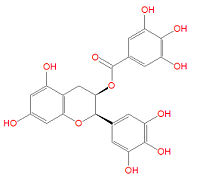Epigallocatechin gallate (EGCG): Difference between revisions
Jump to navigation
Jump to search

imported>David E. Volk (New page: {{subpages}} right|thumb|200px|EGCG '''(-)-Epigallochatechin gallate''', often called '''EGCG''', is a chemical found in green tea and herbal suppliments which proponent...) |
imported>David E. Volk (Stub for the Herbal suppliment) |
||
| Line 1: | Line 1: | ||
{{subpages}} | {{subpages}} | ||
[[Image:EGCG.jpg|right|thumb|200px|EGCG]] | [[Image:EGCG.jpg|right|thumb|200px|EGCG]] | ||
'''(-)-Epigallochatechin gallate''', often called '''EGCG''', is a chemical found in green tea and herbal suppliments which proponents suggest provides healthful benefits. | '''(-)-Epigallochatechin gallate''', often called '''EGCG''', is a chemical found in green tea and herbal suppliments which proponents suggest provides healthful benefits. Recent scientific literature has shown it inhibits the formation of amyloid fibrils or agrregates.<ref>{{cite journal|title=EGCG redirects amyloidogenic polypeptides into unstructured, off-pathway oligomers|author=D.E. Ehrnhoefer, J. Bieschke, A. Boeddrich, M. Herbst, L. Masino, R. Lurz, S. Engemann, A. Pastore & E.E. Wanker|journal=Nature Structural & Molecular Biology|volume=15|pages=558-566|year=2008|doi=doi:10.1038/nsmb.1437</ref> | ||
== References == | |||
<references/> | |||
Revision as of 12:55, 12 June 2008
(-)-Epigallochatechin gallate, often called EGCG, is a chemical found in green tea and herbal suppliments which proponents suggest provides healthful benefits. Recent scientific literature has shown it inhibits the formation of amyloid fibrils or agrregates.[1]
References
- ↑ {{cite journal|title=EGCG redirects amyloidogenic polypeptides into unstructured, off-pathway oligomers|author=D.E. Ehrnhoefer, J. Bieschke, A. Boeddrich, M. Herbst, L. Masino, R. Lurz, S. Engemann, A. Pastore & E.E. Wanker|journal=Nature Structural & Molecular Biology|volume=15|pages=558-566|year=2008|doi=doi:10.1038/nsmb.1437
